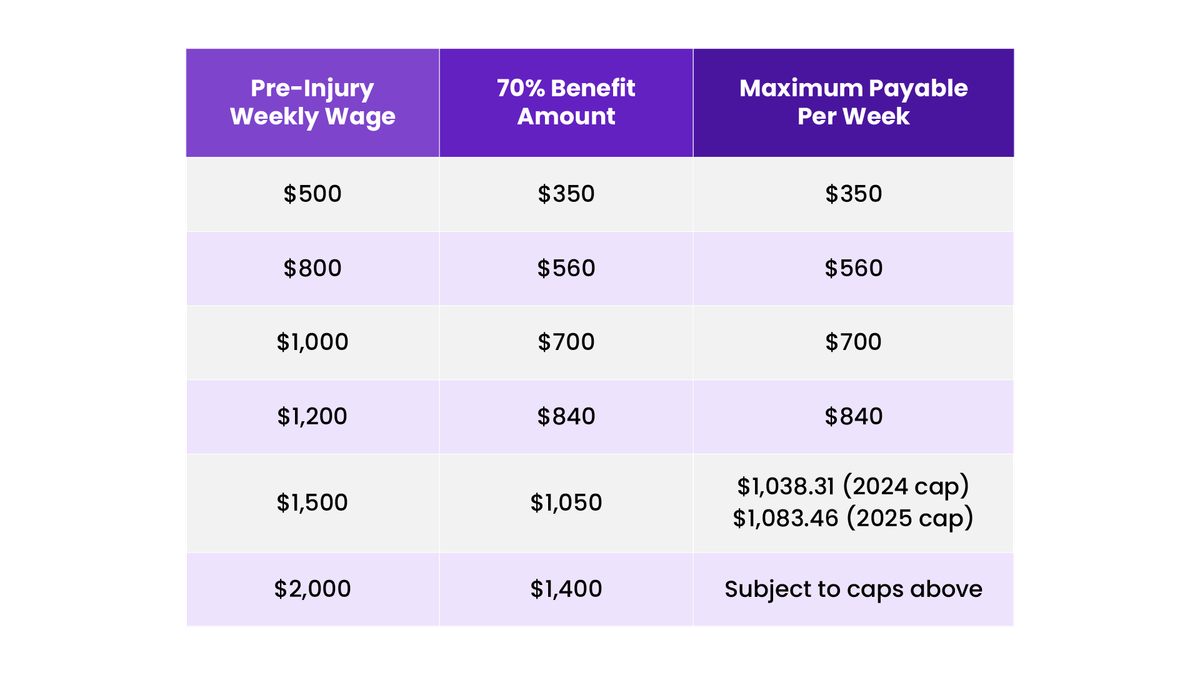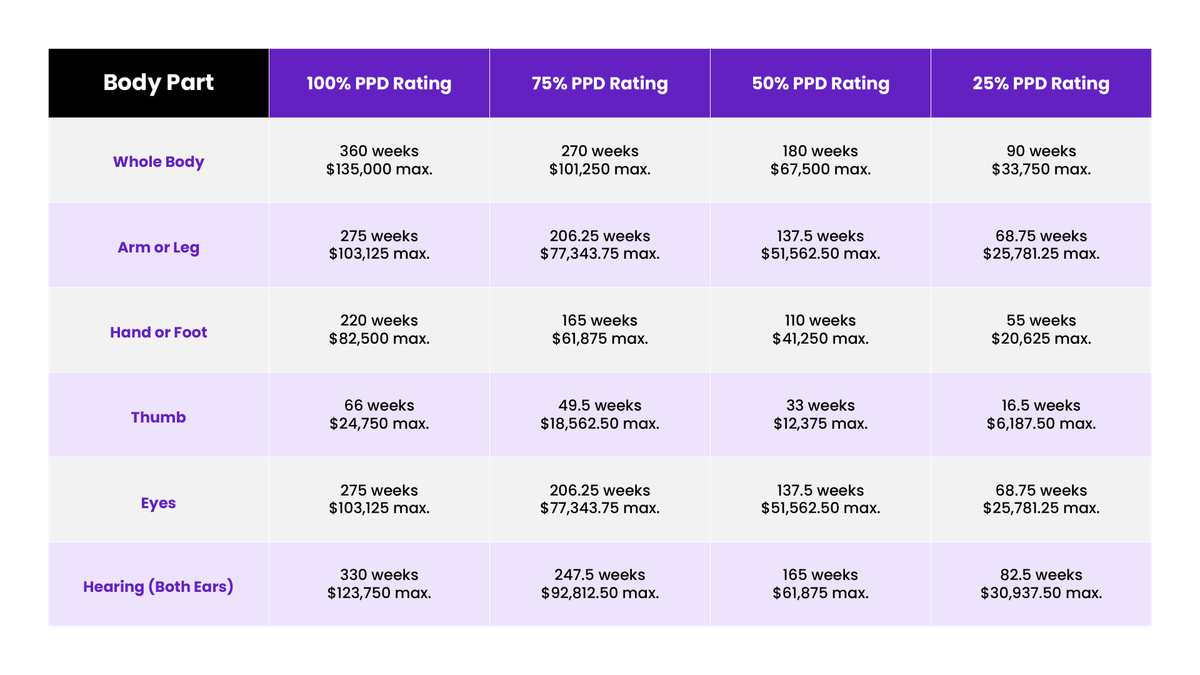Work-related injuries can leave you with medical bills, lost wages, and plenty of uncertainty. You may be wondering how much compensation you’re entitled to and how long benefits will last. Workers’ compensation in Oklahoma is designed to cover medical expenses and lost wages, but the amount you receive depends on several factors, including your earnings before the injury and the severity of your condition.
Oklahoma workers' comp settlement charts can help explain how different types of benefits are calculated and how various factors impact the final amount, but there are a few different charts to be aware of and the benefit amounts can change each year. We’ll go over all the details for 2025* so you can make an informed decision.
* The data referenced in this article frequently changes and is provided as an example only. Please refer to the official State benefit charts for certified figures.
Is There a Cap on Workers’ Comp Settlements in Oklahoma?
Yes, Oklahoma has caps on workers' comp benefits. The maximum amount you can receive depends on the type of disability you have and is based on your average weekly wage before the injury. There are also limits on how long you can receive benefits. For example, temporary total disability (TTD) has a 156-week limit, but some injuries have much shorter timeframes.
The state also limits benefits based on the Oklahoma average weekly wage (AWW). Even if you earned a high salary before your injury, your payments cannot exceed a certain percentage of the state's AWW. These caps help determine the maximum settlement you may receive.
How Much Is a Workers’ Comp Settlement in Oklahoma?
Workers' comp settlements vary widely. Cases can settle for a couple thousand dollars or reach upwards of tens of thousands of dollars. The final amount depends on several factors, including your disability rating, medical bills, lost wages, and ongoing treatment needs.
There are several types of disability benefits that appear in Oklahoma workers’ comp settlement charts, each with different calculations and payout structures. Below, we break down the different types and what you can expect based on your situation.
Temporary Total Disability (TTD)
If your work injury leaves you completely unable to perform your regular job or an alternative job, you may qualify for temporary total disability (TTD) benefits. These benefits provide financial support while you recover and are meant to replace a portion of your lost wages.
TTD benefits are calculated as 70% of your average weekly wage in the year before your injury. However, Oklahoma limits the maximum amount you can receive based on the state’s AWW:
- For injuries that happened in 2024, the maximum weekly TTD benefit is $1,038.31.
- If the injury happened in 2025, the maximum increases to $1,083.46 per week.
The length of time you can receive TTD payments depends on the nature of your injury:
- The maximum amount of time is 156 weeks (three years) of benefits.
- Soft tissue injuries, such as sprains or strains, are limited to eight weeks.
- Hernias qualify for a maximum of six weeks of benefits.
- Psychological conditions related to the injury, such as PTSD caused by a physical injury, qualify for 26 weeks.
Temporary Partial Disability (TPD)
If you’re able to work in a limited capacity but can’t return to your full duties, you may be eligible for temporary partial disability (TPD) benefits. These payments help bridge the gap between your reduced earnings and your pre-injury wages.
TPD benefits are 70% of the difference between your old wage and your current earnings. However, your combined earnings plus TPD benefits cannot exceed the maximum weekly TTD rate of $1,038.31 in 2024 or $1,083.46 in 2025.
You can continue receiving TPD benefits until:
- You reach maximum medical improvement (MMI)—meaning your condition is not expected to improve further with treatment.
- You return to work at your pre-injury wage.
- You reach the 52-week limit on TPD benefits.
Permanent Partial Disability (PPD)
If your injury leaves lasting limitations but still allows you to work, a doctor will assign you a permanent partial disability (PPD) rating. This rating, expressed as a percentage, determines how much compensation you’ll receive.
PPD benefits are 70% of your pre-injury weekly wage, up to a maximum of $360 per week. The total number of weeks you can receive payments depends on your PPD rating and the body part affected. You’ll receive these payments even if you return to work.
Some workers choose to receive weekly PPD payments, while others negotiate a lump sum settlement instead. A lump sum can provide immediate financial relief but may waive your right to future benefits.
Permanent Total Disability (PTD)
If your injury prevents you from working in any capacity, you may qualify for permanent total disability (PTD) benefits. These benefits are calculated the same way as TTD and provide long-term financial support.
PTD benefits continue for at least 15 years or until you reach full Social Security retirement age, whichever is later. However, you must submit a yearly affidavit confirming that you’re still unable to work.
Death Benefits
When a worker dies due to a job-related injury, their spouse and children may qualify for death benefits from their workers’ compensation insurance. These payments help cover lost income and funeral costs.
Surviving spouses can receive a lump sum of $100,000 plus a weekly payment of 70% of the deceased worker’s average weekly wage, subject to the state’s wage caps. For dependent children, the benefits adjust based on the number of children (It can get confusing, so Oklahoma workers’ comp settlement charts are key.) How long family members can receive benefits also depends on the relationship:
- A surviving spouse receives benefits until remarriage and will receive a lump sum upon remarrying.
- Children receive benefits until age 18, or until age 23 if they are full-time students.
- If a child has a disability that prevents them from supporting themselves, benefits may continue indefinitely.
What Impacts a Workers’ Comp Settlement Amount?
It’s difficult to give an average amount for a workers’ comp settlement because it depends on so many different factors, like:
- Your salary: Since benefits are based on a percentage of your pre-injury earnings, higher salaries lead to higher weekly payouts, up to the AWW cap.
- The type of injury or illness: More serious conditions, such as spinal cord damage or traumatic brain injuries, often result in higher settlements than minor fractures or sprains.
- The severity of your condition: Injuries that lead to permanent impairments or long recovery times generally result in higher payouts.
- Medical care required: Workers' comp covers all reasonable and necessary medical treatment without copays or deductibles. A higher cost of treatment, including doctor visits, surgeries, therapy, medications, and assistive devices, can mean a higher settlement.
Does Surgery Increase a Workers' Comp Settlement in Oklahoma?
Surgery can increase the total settlement amount because it directly impacts both medical expenses and disability ratings. A worker who requires surgery typically receives higher compensation for medical bills and may qualify for longer TTD payments while recovering. In addition, needing surgery often indicates a more serious injury, which can lead to a higher PPD rating and increased long-term benefits.
Oklahoma Workers’ Comp Settlement Charts
Workers’ compensation settlements are based on a variety of factors, and Oklahoma uses specific charts and tables to help determine benefit amounts. These charts account for the type of injury, the severity, the body part affected, and the number of dependents (in death benefit cases). Below are some of the most commonly used workers’ comp settlement charts in Oklahoma.
Total Disability Benefits Chart
Total disability benefits, including temporary total disability (TTD) and permanent total disability (PTD), are based on 70% of your pre-injury weekly wage, up to a cap set by the state. If your earnings were lower than the cap, your benefit is based on 70% of your actual wages. Here are a few examples of common weekly wages and the associated workers’ comp benefits:

Permanent Partial Disability (PPD) Rating Chart
For workers with permanent partial disabilities (PPD), Oklahoma assigns a percentage-based impairment rating and uses a schedule of injuries to determine how long benefits last. Different body parts qualify for different numbers of weeks of compensation.
The Oklahoma workers’ comp settlement chart below shows the maximum amounts for various body parts and PPD ratings. To calculate your PPD benefit, multiply 70% of your weekly wage (up to a maximum of $360 per week) by the number of weeks assigned to your specific injury and impairment rating.

What Should I Do Next?
If you’ve been injured at work, taking the right steps early on can protect your rights and help you receive the compensation you deserve. Here’s what you need to do:
- Report your injury to your employer. Oklahoma law requires you to inform your employer as soon as possible and always within 30 days of the injury. If you wait too long, the insurance company may deny your claim by arguing that your injury wasn’t work-related.
- Seek medical treatment right away. Workers’ compensation should cover all necessary medical care, including emergency visits, doctor’s appointments, surgeries, medications, and therapy. If your employer refuses to approve treatment or denies coverage for certain procedures, an attorney can step in to fight for your rights.
- File a workers’ comp claim promptly. Your employer is responsible for submitting your claim to their insurance provider, but some companies delay or mishandle the process. If your employer fails to file your claim or disputes your injury, a workers' comp attorney can step in and file on your behalf.
- Understand that insurance companies try to pay less. Insurance providers often try to limit their payouts by denying claims, undervaluing settlements, or refusing to cover certain medical treatments. If you receive a low settlement offer or a claim denial, don’t accept it without consulting a workers’ comp lawyer.
- Consider legal help for a workers’ comp appeal. If your claim is denied or undervalued, you have the right to file an appeal with the Oklahoma Workers’ Compensation Commission. This process can involve hearings, medical evaluations, and legal arguments, all of which an attorney can handle to maximize your chances of success.
- Explore a personal injury claim for additional compensation. If your injury was caused by a third party, like a subcontractor or a manufacturer of defective equipment, you may be able to file a personal injury claim in addition to workers' comp. (Spouses and children may be able to file wrongful death claims.) A lawsuit can provide compensation for pain and suffering, lost future wages, and more, which workers' comp does not cover.
The Bottom Line
If you’re struggling with understanding a Oklahoma workers’ comp settlement chart, received a low settlement offer, or have an employer who refuses to cooperate, an experienced attorney can fight for the compensation you deserve. Whether you need help filing a claim, fighting a denial, or negotiating a fair settlement, our legal team can handle the hard work so you can focus on recovery. Contact the Oklahoma Injury Guy today for your free case evaluation.

